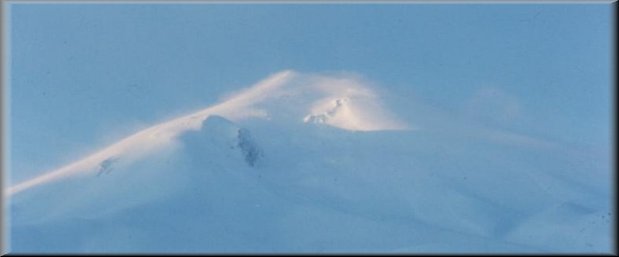
 |
Our plan was to arrive at base in the late morning and immediately begin our climb. We would cut a snow bench to camp about halfway up, and make the summit early the next morning. The wind began to pick up as we approached the area we wanted to camp carrying with it blown snow and ice crystals. Even though we could see clear sky directly overhead, we realized we were in for a difficult night. We cut the bench and pitched tents in steadily deteriorating conditions. Soon we were in a full "whiteout" with zero visibility and had to spend the rest of the afternoon in the tents hoping for better conditions in the morning. The blowing snow and ice loaded on the tents and eventually collapsed one. The night was an odessy of misery punctuated by brief struggles outside in the blizzard digging the snow off the remaining tent. The morning arrived with no abatement in the whiteout and we worried about our ability to find our route off the mountain. Digging out the two now-collapsed tents was a welcome activity after the boredom and worry of the prior night. As we worked our way down the mountain the wind slowed and visibility returned. The last obstacle was a low snow ridge which we needed to cross to get to the snow field which led to our base and vehicles. The ridge was low and not impressive, but the wind across it blew about 70 to 80 miles and hour. It would be impossible to stand in such conditions so we laid down and inched up the side, the wind increasingly pulling on us as we neared the crest. Finally, in the lee side we were free to stand and, defeated, to return to our cars and homes.
Back at the vehicles, I still recollect looking back at the mountain, brilliant in the clear January sky. At the summit I could see huge plumes of snow and ice crystals blowing off the top. Benign in the clear light of day, I well knew the danger that invitation posed. On 18 May, 1980 the mountain immolated itself in a blast of fire and ash. I reflect the many days I spent on the slopes now destroyed. Climbs both successful and not, all in the past. I left a part of myself on the mountain which must remain, perhaps buried in the ash, but ever close in my memory.